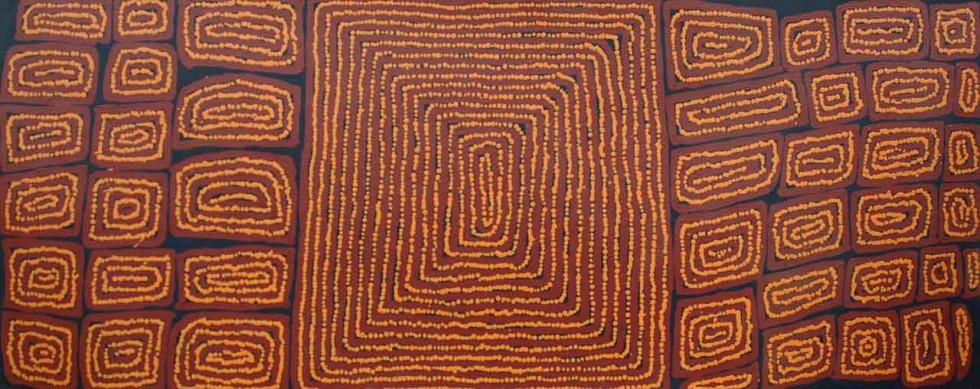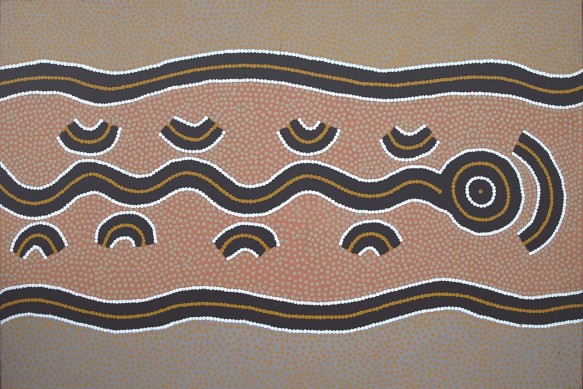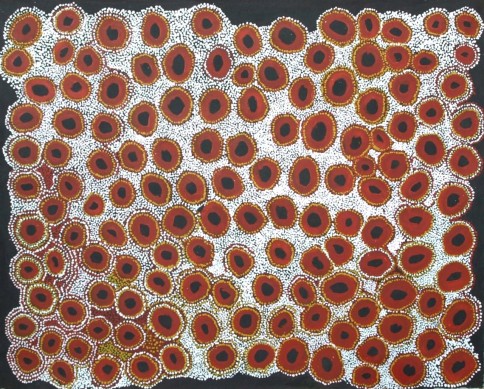Landmarks and Law Grounds: Men of the Desert
Gallery 2
April 12, 2013 - May 22, 2013
The True Custodians
Lyn DiCiero, The West Australian, April 19, 2013
A first for Japingka Gallery in Fremantle, and five years in the planning, Landmarks and Law Grounds: Men of the Desert is an overarching survey of some of the most important male artists of the indigenous contemporary art movement in the past 30 years.
The exhibition is so extensive that part of it is presented on the gallery website due to a lack of wall space to accommodate it. Focusing on paintings of the stories of the ancestral lands of senior indigenous men in the north west Kimberley to the Western and Central deserts, many works are so rare they’re more likely to be seen in museums or State and national galleries rather than up for sale.
A blend of works from private collectors and the gallery’s collection, the exhibition features a stunning early work by the late Rover Thomas as well as work from the likes of Paddy Bedford, Jimmy Pike and Bill Whiskey Tjapaltjarri. How much, I hear you say? Well, works start at $200, but the most expensive, a 1985 Thomas on plywood, could be yours for $135,000. Eight paintings have already been purchased by the Burkhardt/Felder Foundation Museum in Switzerland.
Of the 35 male artists in the exhibition, the youngest is in his 50s and seven are deceased. Japingka co-director Ian Plunkett said the older artists represented the end of an era. “With their passing we won’t see the likes of these artworks again,” he said.
“While the indigenous fine art movement came along too late for a lot of them to be in their prime, the paintings have a real power and integrity you find less of in younger artists. It’s there, but there’s something about these works by older artists who feel that really strong connection to their land, and you feel it in their paintings.”
Included are the works of three brothers, Warlimpirrnga, Walala and Tamlik (Thomas) Tjapaltjarri, who were among the last to leave their nomadic life in the Gibson Desert 30 years ago. Plunkett said the creation stories they painted were pretty much unchanged since being painted on their bodies for ceremonies or drawn in the sand. “When they walked out of the desert it was a real shock as they’d not seen cars before or anything like that,” he said. “They thought they were moving rocks.”
Tjapaltjarri didn’t start painting until he was 80, but in the four years before he died in 2008, he won the 2004 Wynne Prize for Landscape and had a sellout show in London where six of his works achieved more than $250,000. Plunkett said when Tjapaltjarri died it was like a feeding frenzy. “I’d not seen such a demand for an artist before.”
He believed the older-generation artists were the exponents of the truest form of indigenous art based on ancient stories. “It’s the old people who were the last people to be fully initiated, they were born in the desert and have no birth certificate. They see themselves as the true custodians of the ancient Dreaming stories, and yes, the stories are being passed on, but the younger people interpret them in their own way.”
Included is a rare canvas by Pike, whose main output was on paper. When Pike was in Fremantle Prison in the late 1970s and early 1980s, Japingka co-director David Wroth was an art tutor there.
“Jimmy, along with a number of very good artists in Fremantle Prison at that time, were keen to be able to continue to carry on as artists when they went back to their communities,” he said. “It was still a new thing in the Kimberley, the idea you could actually exist professionally as an artist, and Jimmy Pike was very assertive about that.
“He was an extraordinary artist, varying between bright colours and earthy colours. His material of choice was often texta pens, which had such luminous colour, so there was quite a difference between his drawings on paper and the often earthy tones in his paintings.”
Wroth said up to 75 per cent of indigenous artists were women. “It’s great to put the focus on men occasionally, especially senior men and we wanted to put together a group of the best we could.” Landmarks and Law Grounds: Men of the Desert continues at Japingka until May 22.
Further information is available on exhibiting artists on the following links
Willie Kew
Jock Mosquito
Jack Britten
Thomas Tjapaltjarri
Walala Tjapaltjarri
Jimmy Pike
Freddie Timms
Jack Dale
George Tuckerbox
Ronnie Tjampitjinpa






























